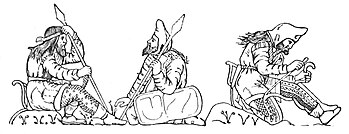Kul-Oba
Kul-Oba ( Ukrainian / Russian : Куль-Оба, Crimean Tatar : Kül Oba) translates as "ash hill". The term refers to an archaeological site of a Scythian tumulus near Kerch in eastern Crimea in Ukraine .
discovery
Kul-Oba was discovered in 1830 and was therefore the first modern Scythian burial mound. An abundance of valuable artifacts were found in the stone grave , which also drew general interest to the Scythian world. The treasures suggest a royal burial mound. Of particular interest was a finely granulated earring with two Nike figures, which, along with other finds, can be viewed in the Hermitage today. Many of the finds show that here, north of the Bosporus, a culture was formed by Hellenistic and Scythian influences.
Finds
The barrow was built between 400 and 350 BC. Built probably by experts from Pantikapaion , a Greek colony in the Crimea. The floor plan is square and measures 4.20 by 4.60 meters. The stepped grave vault was 5.30 meters high. The wooden ceiling was supposed to represent a Scythian canopy.
The body of the king or prince lay on a precious wooden couch near the eastern wall. A tiara , surmounted by a felt cap with a golden pendant, crowned his skin and shows his prominent social position. Around his neck he wore a gold disc weighing 461 grams. Up to three bracelets adorned his wrists. Next to the body there was an ampoule, a whip, a knife and a quiver, all richly decorated with gold and precious stones.
To the left of the couch was a cypress and ivory sarcophagus . Inside was the body of a woman, probably the king's wife or concubine. She wore clothes made of brocade and was crowned with a diadem made of electrum with gold pendants. She also wore two openwork earrings, a gold disc, a gold necklace and two gold bracelets. A bronze mirror with a gilded handle was placed next to her. An electrum cup, placed between her feet, showed illustrations of Scythian mythology.
The remains of a slave - possibly a charioteer - have been found on the south wall. A small niche in the wall contained horse bones, a helmet, a bronze scabbard, and two spearheads. Some silver containers and bronze cauldrons with lamb bones were deposited along the walls. Remains of dried up wine were found in amphorae . Bronze arrowheads were strewn across the floor.
The archaeologists in charge suspect no hidden chambers. Some of the found objects looted by robbery graves were subsequently found by the Russian government.
Picture gallery
Remarks
- ↑ Description in English with pictures from the Hermitage ( Memento of the original from May 27, 2007 in the Internet Archive ) Info: The archive link was inserted automatically and has not yet been checked. Please check the original and archive link according to the instructions and then remove this notice.
- ^ Prehistoric Art, Virtual Museum, illustration of the cup
literature
- NL Grach: Kul-Oba Studies . Part II .: The Kul-Oba "King" . In: Ancient Civilizations from Scythia to Siberia 7, 1-2, 2001, ISSN 0929-077X , pp. 19-28.
- NL Grach: Kul-Oba Studies . Part IV .: The Semantics of the Name Kul-Oba . In: Ancient Civilizations from Scythia to Siberia 7, 1-2, 2001, ISSN 0929-077X , pp. 39-43.
- Michael Rostovtzeff : Skifija i Bospor. Kritičeskoe obosrenie pamjatnikov literaturnych archeologičeskich . Rossiyskaya Akademiya Is. Materialʹnoj Kulʹ'tury, Leningrad 1925.



